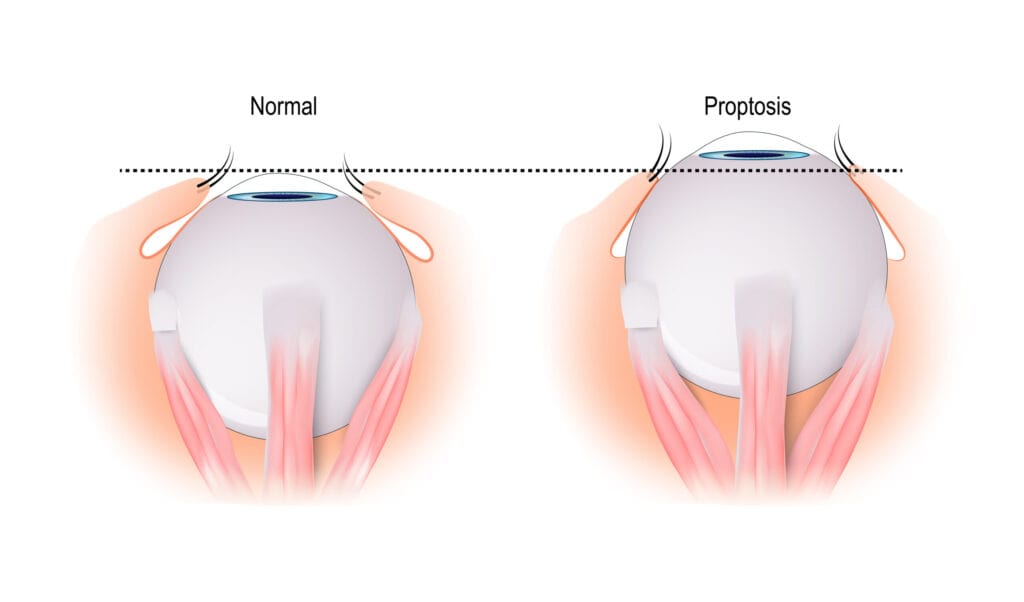Conditions
Proptosis
Proptosis is an eye condition that affects your vision and appearance, which may, in turn, impact your confidence and self-esteem.
What is proptosis?
Proptosis, also known as exophthalmos or thyroid eye disease, is a condition that causes your eyes to bulge out of their natural position.
The bulging of your eyes may make it difficult for you to blink, which can lead to a lack of lubrication on the outer layer of your eyes (cornea).
In addition to cornea damage, proptosis may also cause other complications, such as double vision or low vision.


What causes proptosis?
The most common cause of proptosis is Graves’ disease.
Grave’s disease is an autoimmune disorder that affects your thyroid gland and the tissue behind the eye.
Aside from Graves’ disease, the causes of proptosis include the following:
- Hyperthyroidism
- Eye socket infections
- Injuries that result in bleeding behind the eye
- Tumours such as neuroblastoma and some soft tissue sarcomas
Proptosis symptoms
If your eyes are bulging, you may notice that the white part of your eyes is more visible, and your eyeballs are pushed forward from your eye sockets.
Other symptoms of proptosis that your ophthalmologist should promptly evaluate include the following:
- Sudden onset of bulging, pain, or redness in your eyes
- A throbbing sensation in your eyes
- Eyelid swelling
- Dryness, irritation or watering of your eyes
- A gritty sensation when you move your eyes
- Muscle tightness that prevents you from moving your eyes
- Blurred or double vision
- Sensitivity to light
You should contact your eye specialist if you experience any of the above symptoms in only one eye.

Proptosis diagnosis
Your ophthalmologist will first establish your medical history and ask about your symptoms to diagnose proptosis.
They will also perform a comprehensive eye exam, which may involve the following:
- Using a slit lamp to magnify the surface and structures of your eyes
- Assessing eye and eyelid movement
- Checking for redness, soreness, and irritation
Additional tests your eye specialist may recommend to diagnose proptosis include the following:
- Exophthalmometry to measure how far your eyeball is protruding from the eye socket
- Blood tests to assess for thyroid disease
- Imaging studies like a CT scan or an MRI to look for bleeding, tumours, or signs of infection

Proptosis treatment
If you have proptosis, your treatment options may include using artificial tears, such as drops or gel, to alleviate dry eyes and protect your cornea.
If an infection is present, your opthalmologist may prescribe antibiotics.
In cases where proptosis is related to an underlying condition, such as hyperthyroidism or thyroid eye disease, your eye specialist may recommend IV medications like teprotumumab (Tepezza®).
Other non-surgical treatments for bulging eyes may include
- Using prisms that attach to your glasses to treat double vision.
- Taking immunosuppressive drugs that reduce the impact of immune system attacks on your eyes.
- Corticosteroid injections to reduce swelling or restore eyesight.
In some cases, surgery may be necessary to:
- Remove a tumour and create more space behind your eye in the eye socket.
- Treat double vision.
- Protect your cornea if you are unable to close your eyelids fully.
Why choose Vision Pros to treat your proptosis?
- Experienced ophthalmology team with expertise in all areas of ophthalmology, optometry, and general eye care.
- Rapid access and referral to world-class comprehensive screening and cutting-edge treatment in a state-of-the-art ophthalmology clinic.
- Holistic, personal, and patient-centric approach to every aspect of eye care.
Book an appointment for your comprehensive eye examination today
- https://www.nei.nih.gov/learn-about-eye-health/eye-conditions-and-diseases/graves-eye-disease
- https://my.clevelandclinic.org/health/diseases/21537-bulging-eye#:~:text=What%20is%20proptosis%3F,It’s%20also%20called%20exophthalmos.
- https://www.msdmanuals.com/professional/eye-disorders/symptoms-of-ophthalmologic-disorders/proptosis
- https://www.ncbi.nlm.nih.gov/pmc/articles/PMC7204542/